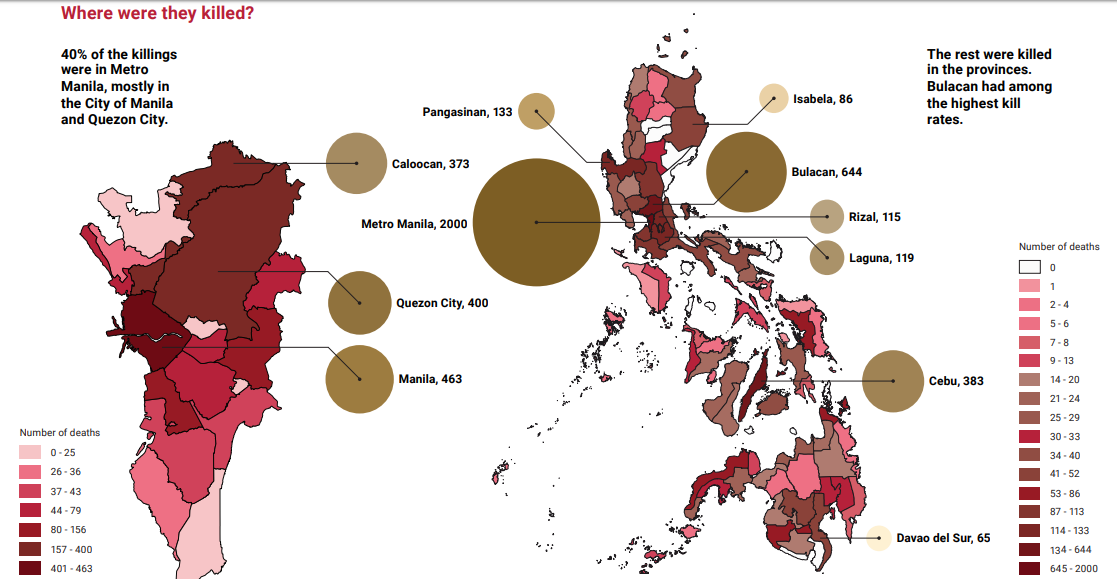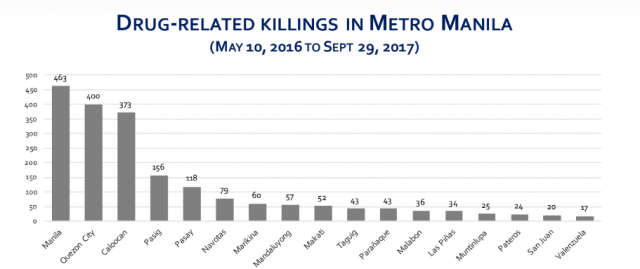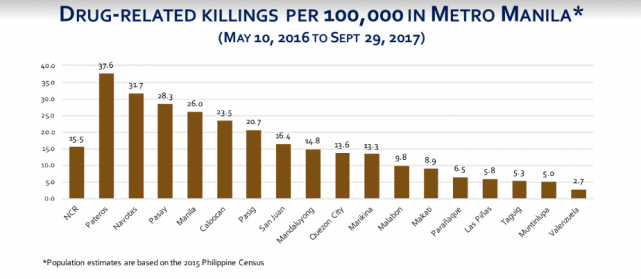NCR was biggest hotspot for killings in 1st year of war on drugs — research

The National Capital Region (NCR) was the largest hotspot for drug-related killings in the first year of President Rodrigo Duterte's war on drugs, according to a study produced by a consortium of researchers from four schools.
Initial findings from this two-part research project, presented on Monday, showed that 2,000 of the 5,021 killings verified through publicly available information from May 10, 2016 to September 29, 2017 were in Metro Manila.
Of the 2,000, the City of Manila had the most deaths with 463, followed by Quezon City with 400 and Caloocan City with 373.

The small municipality of Pateros had the highest density of deaths, with 37.6 deaths per 100,000 population, well above Metro Manila's overall density of 15.5 deaths per 100,000 population.

Outside of Metro Manila, the provinces with the most deaths in the first year of the war on drugs were Bulacan, with 644 killed, and Cebu, with 383.
The figures were revealed at the "The Philippine Government’s Anti-drug Campaign: Emerging Evidence and Data" forum at the Ateneo de Manila University (ADMU).
All of the information in the datasets presented were gathered from publicly available news, affidavits, and court filings on "drug-related" news reports or reports where sources allege a connection with the sale or use of illegal drugs.
Because the data was culled from public reports, areas where media coverage is sparse may have more incidents than reported.
Youths, elderly, poor Filipinos in danger
Though victims are not completely profiled, enough reports distinguished their age and occupation to show that youths, the elderly, and poor Filipino families were highly vulnerable during this period.
About 22 children aged below 18, as well as 34 seniors above 60, were killed from May 2016 to September 2017, while at least 223 individuals had low-income or informal jobs.
Dr. Ronald Mendoza, Dean of the Ateneo School of Government (ASG), said some of the poor individuals were not drug addicts but used illegal substances to stay awake at work.
"According to his wife, he used shabu to stay awake for his work, and he never sold drugs. He was the father of three small children; the youngest was two years old," Mendoza said of a suspect whose nine-year-old was killed alongside him.
Nanlaban, killed at home
More than half, or 55 percent, of the 5,021 (2,753) victims killed in drug-related incidents were killed in police operations, while 38 percent or 1,907 were killed by assailants. The remaining seven percent, consisting of 355 bodies, were discovered or found.
Of the individuals accused of involvement in the drug rate, 47 percent or 2,335 persons were accused of being drug pushers, while 35 percent or 1,752 persons were suspected of drug involvement.
Seventy percent or 371 of 533 people who surrendered during "Oplan Tokhang" and 50 percent or 573 of 1,149 people alleged to be on a "drug watch list" were slain by unknown assailants.
A sizeable amount of victims, 1,711, were killed inside private residences.
Peaks
Drug-related killings per day peaked on September 21, 2016, when 49 deaths linked to anti-illegal drug operations were recorded, and again on August 15, 2017 when police again recorded 49 deaths in one day. Teen Kian delos Santos was killed in a police operation in Caloocan the next night, August 16.
On a per-month basis, July 2016 had the most recorded incidents at 738 deaths. The figures sloped downwards to 95 from September 1 to September 29, 2017.
Government also affected
Police, military, and local government officials were also among those slain in incidents related to the government's war on drugs.
Current and former police officers (107), police assets and informants (9), and retired and active soldiers (11) were also among those whose deaths are linked to the drug campaign.
Sitting and former barangay councilors (46), current (38) and former (2) barangay captains, barangay employees (28) former municipal councilors (4), and other government employees (12) were also included in the report.
The research and the website Drug Archive Philippines, a website that aims to consolidate data on the government's anti-illegal drug campaign, was produced by the same research consortium.
The consortium consists of researchers from the Ateneo School of Government at Ateneo de Manila University, De La Salle Philippines, the University of the Philippines-Diliman and the Stabile Center for Investigative Journalism at Columbia University’s Graduate School of Journalism. — BM, GMA News



